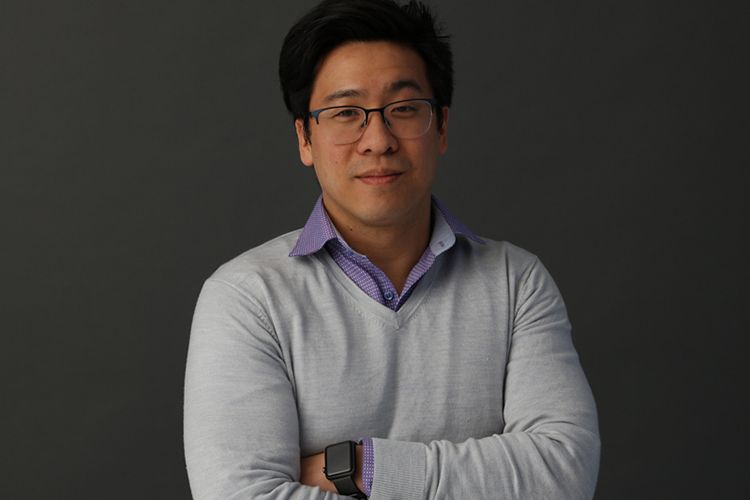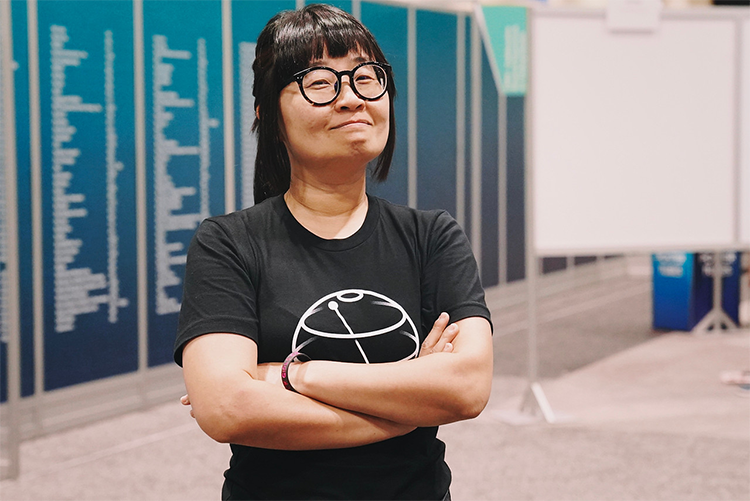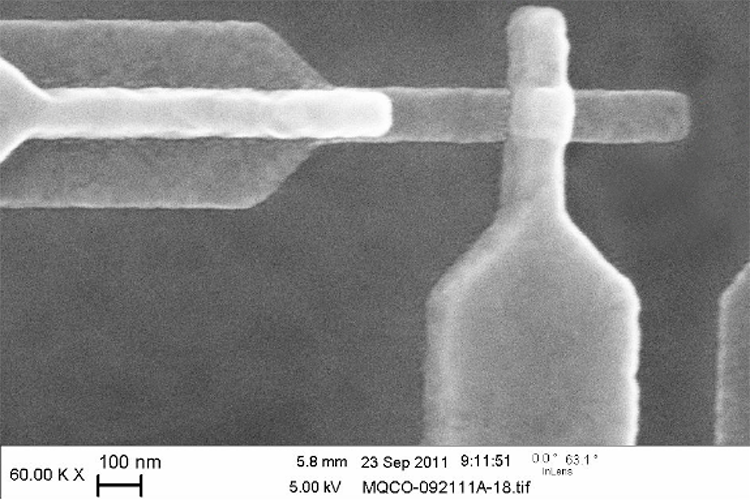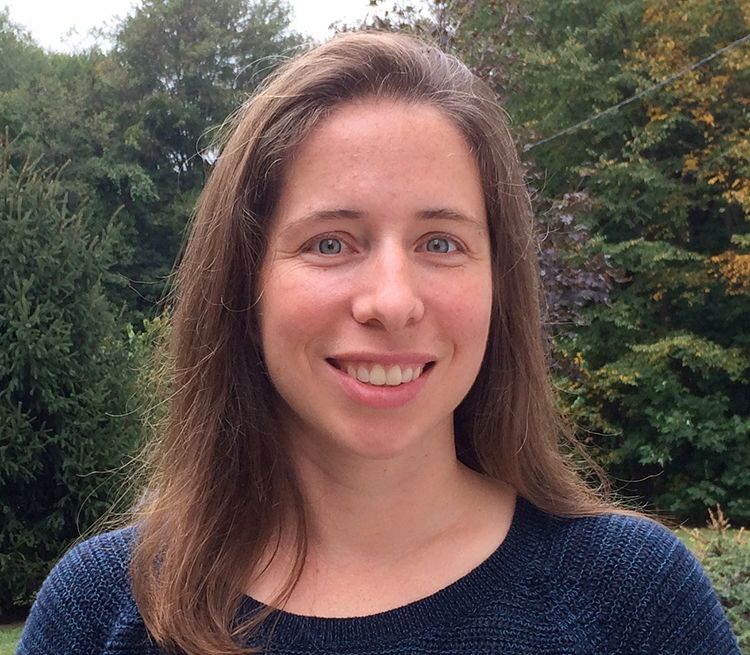Since Leo Esaki
Leo Esaki's discovery of the semiconductor junction, called the Esaki diode, finds wide use in electronics applications. More importantly, his work in the field of semiconductors lays a foundation for further exploration in the electronic transport of solids. Esaki won the 1973 Nobel Prize in Physics for his work in Quantum (or Electronic) Tunnelling. Read more.
According to the APS: “each year, no more than one half of one percent of the Society’s membership is recognized by their peers for election to the status of Fellow.”
Jerry, Hanhee, and Christy all hail from the IBM Quantum team, with expertise across helping drive broad adoption of research done on quantum computers over the cloud; pioneering the superconducting qubit architecture; and scaling superconducting quantum hardware through wafer-level microfabrication and advanced packaging, respectively.
Meet IBM’s newest APS Fellows
Jerry Chow, Director of IBM Quantum Hardware System Development
For seminal scientific contributions to the field of superconducting quantum computing, and for enabling quantum computing to a broad research audience via Cloud accessible devices

Dr. Jerry Chow, Director of IBM Quantum Hardware System Development.
What sparked your interest in quantum?
My earliest physics interest comes from my father, who’s a physics professor. From a young age, he was instilling a lot of math and science into my brain which certainly had a huge influence on the areas of interest I developed. My interest in quantum I think is more rooted from even before I was an undergrad, when I was reading physics magazines about quantum dots. That sounded really interesting to me, and they mentioned that there was a professor working on that at Harvard.
I ended up attending Harvard too, and one random afternoon when I was a sophomore I decided to find that professor—Charlie Marcus. I told him that I had read about his work and would love to be able to learn more. He said sure. We had a nice discussion about what I could learn from him and his work and I started doing research there on quantum dots with carbon nanotubes.
What has your career trajectory been like, and how is the IBM Quantum team helping you pursue your research ideas?
I did my graduate work in Robert Schoelkopf’s group at Yale working on superconducting qubits. My main project there was driving the first two qubit gates, and doing some early demonstrations of quantum algorithms on two-qubit processors.
I joined IBM Research in 2010 as a research staff member. I really saw the team as an up-and-coming avenue to do all kinds of academic-style research with potential industrial rigor. It had this appeal that we had the Microelectronics Research Laboratory to build superconducting devices while still being able to do quantum computing research.
All of this really enabled some of the early exploration from 2010 to 2014 where we could further improve gates, benchmark qubits, and figure out how to control them stably such that we were eventually able to put a quantum computer on the cloud.
Tell us about the work you've been recognized for by the APS. What does this recognition mean to you?
I think a big part of this story was when I started making the cross-resonance gate a robust gate for controlling superconducting qubits, and really pushing the envelope there. Cross resonance gates are a microwave-based gate, as opposed to using magnetic fields to control the different resonances of the qubits—we're using microwaves to drive an interaction to entangle two qubits.
I also helped drive some of the ways that we characterize quantum processors and implemented some of the first quantum algorithms.
This work is now core to the workhorse architecture for all of our deployed devices on the cloud.
Certainly another piece of this is improving quantum processors such that they’re stable enough to put on the cloud. We had to calibrate these devices such that the community can use them, which puts a whole different angle on the needs of these systems. We’re not just building these hero experiments to write one paper—we had to define all the things to make these processors useful for people to write papers and do research. I think it’s really opened up a new field of exploration for how to make robust quantum systems over the cloud.
It’s a tremendous honor to be recognized for my work. The APS Division of Quantum Information through which I received the fellowship has so many well-esteemed people. Plus, it’s been more in the realm of quantum information and theory for a long time, but the division is expanding as quantum computing is taking root, now incorporating the experimental side too. This division is a great forum for sharing ideas in a community of excellent research propelling the field forward, and I'm proud to be a part of that fellow community within that division.
What excites you about the field of quantum and its future?
What doesn't excite me! It may be early, but we're in the stage where the field is growing exponentially in terms of the amount of new research and learning that's being done by having systems available. I'm excited that we're turning quantum into a technology development story and not just a physics for Nature papers story. We're writing down real roadmaps and setting targets for technologies that we need to develop.
I’m excited to continue pushing the envelope in terms of what systems can be built and delivered as we progress along the roadmaps. I think we'll continue to be surprised with what can be done with quantum computing. I think it’s a journey worth embarking on and getting the whole quantum field excited about.
Hanhee Paik, Research Staff Member, IBM Quantum
For pioneering a novel superconducting qubit architecture that catalyzed the commercialization of superconducting quantum computing, and for contributions to advance quantum computing research in the industry

Dr. Hanhee Paik, Research Staff Member, IBM Quantum.
What sparked your interest in quantum?
As a physics student, I was more interested in superconductivity than I was with quantum computing, at first. However, my advisor had invented a superconducting qubit called the phase qubit, and I learned about how we could use Josephson Junctions
Josephson Junctions are junctions where two superconductors sandwich a piece of non-superconducting material.
I still remember the moment I saw the curve on the screen, and realized that I had created the same curve that I had seen in my quantum textbook. I could tangibly feel that quantum mechanics was real. And I wanted to see more quantum mechanical effects in the things I created.
What has your career trajectory been like, and how is the IBM Quantum team helping you pursue your research ideas?
My thesis was about improving coherence times in the phase qubit. I developed a phase qubit that had about 3-4 times longer coherence than any phase qubits previously published.
I did a postdoc at Yale, where I continued to do research on coherence and materials, then worked at Raytheon BBN Technologies before joining IBM. I made the big advance in coherence times that I’m being recognized for by the APS while at Yale.
We could start to do things that we were never able to do with one and two qubits and see all of these quantum effects. At IBM, I continued my research developing new qubit architectures, and had a chance to expand my role to leading the technical project of bringing a 16-qubit processor online, on the cloud. This was the first device larger than 10 qubits introduced in the field of superconducting qubits, and there were so many challenges to overcome in development and bringing it online. I learned a lot beyond the research itself, like how to bring a product to end users.
Tell us about the work you’ve been recognized for by the APS. What does this recognition mean to you?
When I first started my research, there were many different kinds of qubits, including multiple types of superconducting qubits. The transmon qubit—the architecture underlying IBM Quantum’s processors, soon came along, but the highest coherence times that researchers could achieve was only around one microsecond. We didn’t understand what the limiting factor for the architecture was, and as a graduate student and postdoc I helped lead the charge to try and understand what was causing these limits.
My experiment essentially placed a chip with a transmon qubit into a 3D cavity with an antennae that acted as a capacitor, or a component that stores energy. We ran an analysis on the system and were able to figure out that the qubit was heavily influenced by energy lost from the surface or interface of the qubit, where it meets air or substrate. We figured out how to build a much larger capacitor to reduce the effect of surface loss, and we were able to greatly increase the coherence times of transmon qubits. This work proved that surface loss had been limiting the transmon coherence time, and has certainly influenced the way we design our qubits here at IBM.

A Josephson Junction.
With this advance, many in the industry saw that there would be a path forward with superconducting quantum computing for commercialization that can be serviced to the users with long enough coherence.
I became an APS Fellow through the Forum of Industrial and Applied Physics (FIAP). Christy and I are two of only a few Fellows from the quantum industry recognized as Fellows in the Forum, which I think truly shows how much the quantum industry has grown. I feel honored to be recognized for my contribution to the growth of the quantum industry and superconducting quantum computing.
What excites you about the field of quantum and its future?
My invention helped prove that it was possible to commercialize superconducting quantum computing. Ten years later, IBM now has more than 20 systems available to end users, online 24/7, and running about 2 billion circuits everyday on average. I think this is truly extraordinary.
It is an exciting time now, as I see so many people from different disciplines starting to work on quantum computing and the growth of the quantum industry, creating additional opportunities for research. And I believe the field of quantum computing will continue to grow and expand as it has over the past 30 years.
Christy Tyberg, Senior Manager, IBM Quantum Hardware Technology Development
For leadership in scaling superconducting quantum hardware through wafer-level microfabrication and advanced packaging

Christy Tyberg, Senior Manager, IBM Quantum Hardware Technology Development
What sparked your interest in quantum?
This nomination was actually quite a surprise to me—I was not a quantum researcher for most of my career. Not that long ago, I was working on semiconductor hardware research. We were looking at how to improve our classical servers by leveraging 3D chip stacking technology. But on the quantum side, scaling to larger systems was becoming more and more important and I became interested in how I could apply my knowledge of semiconductor technology to work on solving some of the new challenges with quantum scaling.
What has your career trajectory been like, and how is the IBM Quantum team helping you pursue your research ideas?
I’m a chemist by training, but since I’ve been at IBM, that’s morphed into many different things throughout my career. I’d never worked on semiconductors in my graduate work, then I found myself working on semiconductor technology and now quantum technology.
Our team is working toward development of the biggest and the best quantum computers, combining expertise in physics, materials science, signal integrity and hardware fabrication. Through this work, I have been able tap into my background in different areas of materials development and semiconductor technology. It's exciting to be working in a team with some of the world's leading experts across so many disciplines within quantum computing, and continuing to learn and discover new things every day.
Tell us about the work you've been recognized for by the APS. What does this recognition mean to you?
It’s humbling. With my background, being considered for a nomination to a physics society was kind of a shock. I think this nomination is calling out the importance of bringing expertise from different areas and applying it to physics challenges.
Quantum is very different than semiconductor work in many ways, but what's most relevant to scaling quantum systems is that you can’t have all the wiring levels that you have in semiconductor technology, because you have to have a pristine, low-loss surface for the qubits to operate properly. This limitation constrains the ability to scale to larger systems. In quantum we are now using 3D integration technologies, developed for semiconductors and modified for quantum. This allows us to pack more onto the quantum chip and enables larger, more complex systems.
What excites you about the field of quantum and its future?
You have to remember that I’m coming from the semiconductor industry where for most of my career we have been struggling with challenges of approaching fundamental limits to scaling. With each generation scaling is becoming more difficult and resource-intensive with diminishing performance gains.
With quantum now it’s really exciting to have so many unknowns and so much opportunity to discover and to solve problems.
I find myself imagining what people must have been thinking at the beginning of computing: “No one will ever want or need more than this one big room-sized computer.”
And you look at what was achieved. Then you take yourself into quantum, where you have so much potential to discover in a similar way. Hopefully we can also change the world for the better through this technology.




